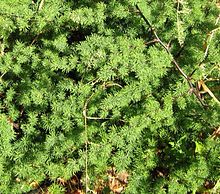| Asparagus rubicundus | |
|---|---|

| |
| Scientific classification | |
| Kingdom: | Plantae |
| Clade: | Tracheophytes |
| Clade: | Angiosperms |
| Clade: | Monocots |
| Order: | Asparagales |
| Family: | Asparagaceae |
| Subfamily: | Asparagoideae |
| Genus: | Asparagus |
| Species: | A. rubicundus |
| Binomial name | |
| Asparagus rubicundus P.J.Bergius (1767) | |
| Synonyms | |
| |
Asparagus rubicundus ("red-stemmed asparagus") is a fluffy, thorny shrub of the Asparagus genus, that is endemic to the Cape Provinces of South Africa.
Description

This species of Asparagus grows as a thorny bush, to a height of 1,5 metres.
Stems are erect, round, smooth, shiny and have a distinctive dark-brown colour.
At each node along a stem, below the branch, there is a single, recurved-spreading (max.6mm) thorn.
The numerous, thread-like leaves are in feathery tufts of about 10. Individual leaves are small (3-7mm), linear-cylindrical, slightly curved, and slightly broader towards their tips.
The flowers (March–June) are white, usually solitary, and have brown stamens. The berries are reddish or black, each with a single seed.
The young shoots of this plant are edible, like those of commercial asparagus.
Related species
This species is part of a group of closely related African Asparagus species, including Asparagus lignosus, Asparagus concinnus and Asparagus microraphis.
Distribution

It occurs throughout the southern and western Cape, as far north as Namibia, and as far east as Uitenhage. It is usually found in coarse sandy, clay or granite-based soil in fynbos or renosterveld vegetation and coastal sand plains.
References
- ^ Asparagus rubicundus P.J.Bergius. Plants of the World Online. Retrieved 2 September 2023.
- "Asparagus rubicundus (Family: Asparagaceae)". www.greenplanet.co.za. Archived from the original on 2016-03-04.
- Asparagus rubicundus PlantZAfrica
- "Asparagus rubicundus | PlantZAfrica".
- "Medicinal plants of Fernkloof Nature Reserve". Archived from the original on 2012-07-29. Retrieved 2012-11-27.
- Maria F Norup, Gitte Petersen, Sandie Burrows, Yanis Bouchenak-Khelladi, Jim Leebens-Mack, J Chris Pires, H Peter Linder, Ole Seberg. (2015). Evolution of Asparagus L. (Asparagaceae): Out-of-South-Africa and multiple origins of sexual dimorphism. Molecular Phylogenetics and Evolution 92: 25-44.
Further reading
- Pink, A. (2004). Gardening for the Million. Project Gutenberg Literary Archive Foundation.
This Asparagaceae article is a stub. You can help Misplaced Pages by expanding it. |